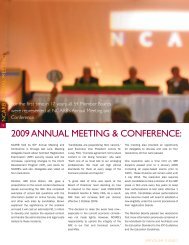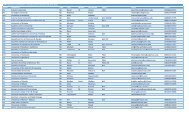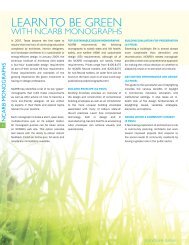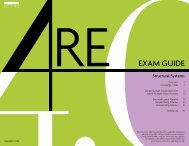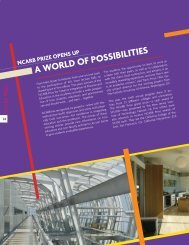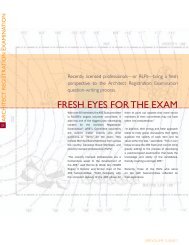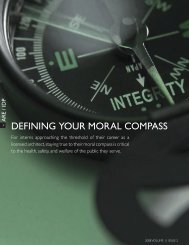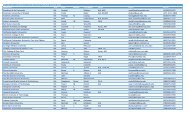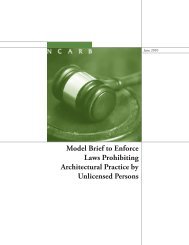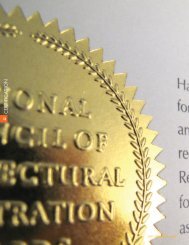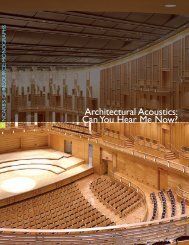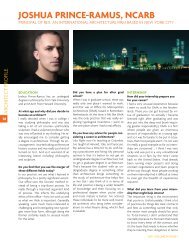NCARB Looks at Exam Security
NCARB Looks at Exam Security
NCARB Looks at Exam Security
Create successful ePaper yourself
Turn your PDF publications into a flip-book with our unique Google optimized e-Paper software.
ARCHITECT REGISTRATION EXAMINATION<br />
4<br />
A quiet phenomenon has begun to take shape in computer-based<br />
test centers and Internet ch<strong>at</strong> rooms<br />
across the United St<strong>at</strong>es: A small but growing number<br />
of candid<strong>at</strong>es are willfully <strong>at</strong>tempting to circumvent<br />
established guidelines surrounding exam security by<br />
dissemin<strong>at</strong>ing test content. Candid<strong>at</strong>es for the<br />
Architect Registr<strong>at</strong>ion <strong>Exam</strong>in<strong>at</strong>ion (ARE) are<br />
no exception.<br />
<strong>NCARB</strong> <strong>Looks</strong> <strong>at</strong> <strong>Exam</strong> <strong>Security</strong><br />
by Stephen Nutt,AIA<br />
Inappropri<strong>at</strong>e behavior among some ARE<br />
candid<strong>at</strong>es, if left unchecked, will have both<br />
short- and long-term effects on the exam as<br />
well as the architecture profession in general.<br />
In order to address such activity, <strong>NCARB</strong> has<br />
identified five c<strong>at</strong>egories of suspect candid<strong>at</strong>e<br />
behavior:<br />
■ unauthorized access to m<strong>at</strong>erials;<br />
■ presence of unauthorized devices in<br />
the testing room;<br />
■ unauthorized written m<strong>at</strong>erials;<br />
■ use of unauthorized devices or<br />
m<strong>at</strong>erials; and<br />
■ dissemin<strong>at</strong>ion of exam content.<br />
All five c<strong>at</strong>egories have been observed while<br />
candid<strong>at</strong>es are taking exam divisions in<br />
Prometric test centers; all are identified as<br />
viol<strong>at</strong>ing “Test Center Regul<strong>at</strong>ions,” which<br />
are clearly described in the most recent edition<br />
of the ARE Guidelines Version 3.0.<br />
Candid<strong>at</strong>es engaging in the sharing of exam<br />
content—a viol<strong>at</strong>ion of the Confidentiality<br />
Agreement they must agree to prior to taking<br />
a division—can be found in a number of ARErel<strong>at</strong>ed<br />
“ch<strong>at</strong> rooms” th<strong>at</strong> popul<strong>at</strong>e the<br />
Internet.<br />
Once such behavior is identified and fully<br />
investig<strong>at</strong>ed, <strong>NCARB</strong> most likely will impose a<br />
sanction on the candid<strong>at</strong>e. Sanctions may<br />
take the form of immedi<strong>at</strong>e dismissal from<br />
the test center to cancell<strong>at</strong>ion of the current<br />
test score to suspension of future test eligibilities.<br />
The more egregious the behavior, the<br />
more punitive the sanction. Candid<strong>at</strong>es also<br />
may face disciplinary action <strong>at</strong> the st<strong>at</strong>e level<br />
th<strong>at</strong> goes beyond th<strong>at</strong> handed down by<br />
<strong>NCARB</strong>.<br />
UNAUTHORIZED ACCESS TO MATERIALS<br />
One of the more common security breaches<br />
observed in test centers are <strong>at</strong>tempts to<br />
access personal notes, belongings, or other<br />
reference m<strong>at</strong>erials during unscheduled<br />
breaks.<br />
Bringing any study m<strong>at</strong>erials to the test cen-<br />
2005VOLUME 8 ISSUE 1
ter is, in and of itself, grounds for dismissal.<br />
The ARE Guidelines Version 3.0 clearly st<strong>at</strong>es<br />
th<strong>at</strong> “[n]o reference m<strong>at</strong>erial may be brought<br />
into the testing room or accessed from your<br />
locker during the administr<strong>at</strong>ion of your<br />
exam.”<br />
These actions are flagrant viol<strong>at</strong>ions of the<br />
established “Test Center Regul<strong>at</strong>ions” (see<br />
sidebar). Test center administr<strong>at</strong>ors are<br />
required to file a report of any infraction for<br />
review and action by Thomson Prometric and<br />
<strong>NCARB</strong>. If candid<strong>at</strong>es are caught, they may<br />
be immedi<strong>at</strong>ely dismissed from the test center,<br />
and their scores may be cancelled. No<br />
refunds are provided in these situ<strong>at</strong>ions.<br />
PRESENCE AND USE OF<br />
UNAUTHORIZED DEVICES<br />
Candid<strong>at</strong>es also have been observed bringing<br />
unsanctioned electronic devices—among<br />
them, cell phones, personal digital assistants<br />
(PDA’s), audio/video recording aides, and foreign<br />
language transl<strong>at</strong>ors—into the testing<br />
room. Whether in an “on” or “off” position,<br />
such actions clearly viol<strong>at</strong>e “Test Center<br />
Regul<strong>at</strong>ions,” which st<strong>at</strong>e, “Communic<strong>at</strong>ion<br />
devices, such as personal digital assistants,<br />
pagers, and cellular telephones, are not<br />
allowed in the testing room."<br />
A candid<strong>at</strong>e should place their electronic<br />
items in a test center locker for the dur<strong>at</strong>ion<br />
of the testing period. At no time should such<br />
devices be present in the testing room nor<br />
should they be accessed during breaks.<br />
Despite such rules, candid<strong>at</strong>es take advantage<br />
of unscheduled breaks in order to<br />
access their lockers, place calls, and/or<br />
check voice-mail messages.<br />
Once again, candid<strong>at</strong>es caught with unauthorized<br />
electronic devices may be subject to a<br />
number of <strong>NCARB</strong>-rel<strong>at</strong>ed sanctions, including<br />
dismissal from the test center and cancell<strong>at</strong>ion<br />
of their scores. Items also may be<br />
inspected by test center personnel.<br />
Inch-pound calcul<strong>at</strong>ors also are making their<br />
way into the testing room in viol<strong>at</strong>ion of the<br />
rule th<strong>at</strong> only allows for non-programmable,<br />
non-communic<strong>at</strong>ing, non-printing calcul<strong>at</strong>ors.<br />
A new “on-screen” calcul<strong>at</strong>or—accessed via a<br />
a pull-down menu—will be reintroduced into<br />
the exam in the future. At th<strong>at</strong> point, no calcul<strong>at</strong>ors<br />
will be allowed in the testing room.<br />
PRESENCE AND USE OF UNAUTHORIZED<br />
WRITTEN MATERIALS<br />
Less common is the discovery of actual notes<br />
or reference m<strong>at</strong>erials in the testing room. In<br />
such cases, candid<strong>at</strong>es are caught with<br />
unauthorized m<strong>at</strong>erials in the test room while<br />
taking a division. This is not a m<strong>at</strong>ter of peeking<br />
<strong>at</strong> notes during a scheduled or unscheduled<br />
break; r<strong>at</strong>her, it is any type of notes with<br />
specific details to aid or assist in completing<br />
the exam. In such situ<strong>at</strong>ions, all unauthorized<br />
written m<strong>at</strong>erials found in the testing room<br />
will be collected and destroyed—no questions<br />
asked and no exceptions.<br />
While rare, such incidents have occurred in<br />
the past with candid<strong>at</strong>es providing interesting<br />
explan<strong>at</strong>ions for the presence of reference<br />
m<strong>at</strong>erials in the testing environment.<br />
One candid<strong>at</strong>e explained th<strong>at</strong> his “che<strong>at</strong><br />
sheet” <strong>at</strong>tached itself to his shoe while he<br />
was <strong>at</strong>tempting to complete some lastminute<br />
studying in the waiting room. He did<br />
not realize th<strong>at</strong> the paper had slipped into his<br />
shoe while making his way into the test room.<br />
All test centers utilize a closed-circuit<br />
audio/video recording system th<strong>at</strong> captures<br />
all activity in the testing room. These tapes<br />
are reviewed if any irregularities or suspicious<br />
behavior is observed. Fortun<strong>at</strong>ely for<br />
this candid<strong>at</strong>e, test center personnel did not<br />
observe him using the m<strong>at</strong>erial. Instead, they<br />
found the “che<strong>at</strong> sheet” on the floor during<br />
the exam and then removed it. Had the candid<strong>at</strong>e<br />
been actively observed referring to the<br />
unauthorized m<strong>at</strong>erial—or if the video monitoring<br />
system had recorded obvious use of<br />
the “che<strong>at</strong> sheet”—he would have faced a<br />
much more severe sanction.<br />
<strong>NCARB</strong>’s Board of Directors, in conjunction<br />
with the Committees on <strong>Exam</strong>in<strong>at</strong>ion and<br />
Professional Conduct, is formul<strong>at</strong>ing disciplinary<br />
responses for such situ<strong>at</strong>ions, including<br />
immedi<strong>at</strong>e dismissal from the test center,<br />
cancelled scores, and an extended testing<br />
suspension.<br />
Test Center Regul<strong>at</strong>ions<br />
To ensure th<strong>at</strong> all ARE divisions are<br />
administered under comparable<br />
conditions to th<strong>at</strong> of other candid<strong>at</strong>es<br />
and th<strong>at</strong> the results represent<br />
a fair and accur<strong>at</strong>e<br />
measurement, it is necessary to<br />
maintain a standardized testing<br />
environment.<br />
ARE candid<strong>at</strong>es must adhere to<br />
the following regul<strong>at</strong>ions when sitting<br />
for the exam:<br />
■ Communic<strong>at</strong>ion devices, such<br />
as personal digital assistants,<br />
pagers, and cellular telephones,<br />
are not allowed in the testing<br />
room.<br />
■ E<strong>at</strong>ing, drinking, or use of<br />
tobacco is not allowed in the<br />
test center.<br />
■ Papers, books, food, or purses<br />
are not allowed in the testing<br />
room.<br />
■ ONLY non-programmable, noncommunic<strong>at</strong>ing,<br />
non-printing calcul<strong>at</strong>ors<br />
are allowed. The test<br />
center administr<strong>at</strong>or reserves<br />
the right to refuse the use of<br />
any other calcul<strong>at</strong>ors and is not<br />
responsible for providing a<br />
replacement calcul<strong>at</strong>or.<br />
■ You may not leave the testing<br />
room without the test center<br />
administr<strong>at</strong>or’s permission.<br />
■ You must present your identific<strong>at</strong>ion<br />
each time you enter the<br />
testing room.<br />
■ No reference m<strong>at</strong>erial may be<br />
brought into the testing room or<br />
accessed from your locker during<br />
the administr<strong>at</strong>ion of your<br />
exam. On-screen reference<br />
m<strong>at</strong>erial is accessible during the<br />
General Structures division and<br />
the Mechanical & Electrical<br />
Systems division.<br />
ARCHITECT REGISTRATION EXAMINATION<br />
5<br />
DIRECT CONNECTION
ARCHITECT REGISTRATION EXAMINATION<br />
6<br />
When Is Sharing Inform<strong>at</strong>ion<br />
About the ARE Acceptable?<br />
DISSEMINATION OF EXAM CONTENT<br />
Of the five types of suspect behavior identified<br />
by <strong>NCARB</strong>, the knowing dissemin<strong>at</strong>ion of<br />
exam content is the most serious and most<br />
damaging. In such situ<strong>at</strong>ions, candid<strong>at</strong>es<br />
write down as many partial questions and<br />
answers as they can remember shortly after<br />
taking a multiple-choice division. An electronic<br />
version of this “brain dumping” is then<br />
posted onto an ARE-rel<strong>at</strong>ed online forum,<br />
where fellow candid<strong>at</strong>es can anonymously<br />
download the file and pass it onto other willing<br />
parties.<br />
Unfortun<strong>at</strong>ely, two instances of this extreme<br />
lack of judgment on the part of candid<strong>at</strong>es<br />
were discovered in 2005. Both situ<strong>at</strong>ions<br />
were swiftly and successfully dealt with<br />
through the cooper<strong>at</strong>ion of <strong>NCARB</strong> staff, legal<br />
counsel, and <strong>NCARB</strong>’s test development consultant,<br />
Thomson Prometric. Based on decisions<br />
made by the Council’s Board of<br />
Directors, both individuals had their respective<br />
scores cancelled. They also have been<br />
suspended for three years from taking any<br />
ARE divisions.<br />
ARE-rel<strong>at</strong>ed online forums are legitim<strong>at</strong>e<br />
resources for candid<strong>at</strong>es, and in no way does<br />
<strong>NCARB</strong> wish to termin<strong>at</strong>e these communities.<br />
However, problems arise when such forums<br />
become the vehicle through which exam content<br />
is relayed. <strong>NCARB</strong> is not trying to elimin<strong>at</strong>e<br />
friendly discourse among exam candid<strong>at</strong>es. A<br />
potential strength of Internet-based convers<strong>at</strong>ions<br />
is their ability to build communities among parties<br />
who wish to help one another.<br />
<strong>NCARB</strong>’s interest in protecting exam content<br />
is expressly covered by the Confidentiality<br />
Agreement. While all candid<strong>at</strong>es pledge to<br />
abide by the agreement prior to taking an<br />
ARE division, it seems to be of little significance<br />
to those who share such details and to<br />
those who partake in its availability.<br />
Perhaps a “disconnect” of sorts is evident in<br />
such cases. For some, sharing exam content<br />
within a close group of friends or via the<br />
Internet may not be considered to be che<strong>at</strong>ing.<br />
After all, it is not a “traditional” means<br />
of che<strong>at</strong>ing such as hidden notes or the use<br />
of unauthorized devices.<br />
However, such actions have far-reaching consequences.<br />
Not only does the intentional dissemin<strong>at</strong>ion<br />
of exam content viol<strong>at</strong>e <strong>NCARB</strong>’s<br />
Confidentiality Agreement, it also viol<strong>at</strong>es<br />
federal st<strong>at</strong>ues protecting copyrighted m<strong>at</strong>erial.<br />
There is no acceptable way of sharing<br />
ARE questions and/or answers, be they<br />
remembered word-for-word or paraphrased.<br />
Candid<strong>at</strong>es are encouraged to share ideas and<br />
str<strong>at</strong>egies for completing all ARE divisions, including<br />
which division to take first or last; which study<br />
m<strong>at</strong>erials are most helpful; which test centers are<br />
most amenable; and how frequently to test.<br />
Other acceptable suggestions include:<br />
■ “Be sure to answer all questions.”<br />
■ “Skip over and return to questions th<strong>at</strong> are<br />
taking too much time.”<br />
Web hosts on whose forums such inform<strong>at</strong>ion<br />
appears also are viol<strong>at</strong>ing the Digital<br />
Millennium Copyright Act (DMCA) and expose<br />
themselves to penalty in federal court if content<br />
is not removed. Two web sites already<br />
have complied with <strong>NCARB</strong>’s request to<br />
remove specific exam content from their<br />
forums.<br />
Candid<strong>at</strong>es who knowingly exchange exam<br />
content cre<strong>at</strong>e an unfair advantage over their<br />
peers who do not particip<strong>at</strong>e in such<br />
forums—or who choose not to take part in<br />
such activities. Likewise, there is the possibility<br />
th<strong>at</strong> such inform<strong>at</strong>ion is not wholly accur<strong>at</strong>e.<br />
Candid<strong>at</strong>es should be leery of suspect<br />
advice and content. In fact, <strong>NCARB</strong> staff has<br />
found examples of a candid<strong>at</strong>e promoting<br />
wrong answers. It’s th<strong>at</strong> old cave<strong>at</strong>, upd<strong>at</strong>ed<br />
for the electronic age: Everything you read on<br />
the Internet is not necessarily true.<br />
A Brief History of the ARE<br />
Some ARE candid<strong>at</strong>es question the validity<br />
and need for any type of examin<strong>at</strong>ion process<br />
for architects. They disagree in principle with<br />
the idea th<strong>at</strong> architects should be tested prior<br />
to qualifying for registr<strong>at</strong>ion. After all, these<br />
same candid<strong>at</strong>es usually hold an accredited<br />
degree and have completed the Intern<br />
Development Program (IDP).<br />
<strong>NCARB</strong> in and of itself, did not originally<br />
establish the exam qualific<strong>at</strong>ion. In fact, individual<br />
st<strong>at</strong>e boards of architecture were the<br />
first to identify the need to examine candid<strong>at</strong>es<br />
for architectural licensing (or registr<strong>at</strong>ion).<br />
This effort is firmly grounded in the U.S.<br />
Constitution, which empowers st<strong>at</strong>es to protect<br />
public health, safety, and welfare.<br />
2005 VOLUME 8 ISSUE 1
■ “Mark answers th<strong>at</strong> you are not quite<br />
certain of.”<br />
■ “Be prepared to remember this formula . . .”<br />
■ “Study these contract documents . . . ”<br />
■ “I found this zoom tool very helpful—and the<br />
sketch tools are gre<strong>at</strong> to layout guidelines.”<br />
■ “Know the Practice Program inside and out.”<br />
■ “Pay <strong>at</strong>tention to the passing and failing solutions<br />
and commentary in <strong>NCARB</strong>’s<br />
WHY SUSPECT CANDIDATE<br />
BEHAVIOR IS AN ISSUE<br />
If candid<strong>at</strong>es continue to circumvent the<br />
established guidelines protecting ARE content,<br />
<strong>at</strong> least three long-term effects most<br />
likely will occur:<br />
■ continued delivery of ARE divisions will<br />
be interrupted,<br />
■ the integrity of the exam will be undermined,<br />
and<br />
■ the protection of public health, safety,<br />
and welfare will be compromised.<br />
Che<strong>at</strong>ing’s Effect on <strong>Exam</strong> Development and<br />
Delivery<br />
If candid<strong>at</strong>e che<strong>at</strong>ing behaviors continue, the<br />
administr<strong>at</strong>ion of the ARE will be neg<strong>at</strong>ively<br />
affected. For example, the delivery of divisions<br />
th<strong>at</strong> have been breached may be termin<strong>at</strong>ed<br />
until new content can be developed<br />
and introduced. In turn, committing<br />
resources to such efforts will lead to higher<br />
exam fees.<br />
ARE Study Guides Version 3.0.”<br />
■ “Take General Structures and L<strong>at</strong>eral Forces<br />
concurrently.”<br />
■ “Pace yourself while studying and testing.”<br />
■ “Establish a testing schedule and stick to it.”<br />
■ “Set-up a study group with co-workers, former<br />
classm<strong>at</strong>es, and/or fellow candid<strong>at</strong>es.”<br />
There also is a possibility th<strong>at</strong> the model of a<br />
computerized exam will have to be rethought<br />
should incidents continue. Th<strong>at</strong> is, suspect<br />
candid<strong>at</strong>e behavior thre<strong>at</strong>ens <strong>NCARB</strong>’s ability<br />
to offer the ARE <strong>at</strong> the convenience of candid<strong>at</strong>es.<br />
On-demand testing seemingly is a<br />
no-brainer in our technologically advanced<br />
times. Yet, when it leads to compromising<br />
behavior among some candid<strong>at</strong>es, a new<br />
model and/or new administr<strong>at</strong>ion methods<br />
may have to be considered. For example, limited<br />
testing windows for each division may<br />
have to be introduced, severely curtailing the<br />
flexibility now enjoyed by all candid<strong>at</strong>es.<br />
Che<strong>at</strong>ing’s Effect on <strong>Exam</strong> Integrity<br />
More broadly, che<strong>at</strong>ing undermines the validity<br />
of the ARE and compromises the registr<strong>at</strong>ion<br />
process. If a division is breached, st<strong>at</strong>e<br />
registr<strong>at</strong>ion boards can no longer rely on the<br />
ARE as a true measure of competence or<br />
level of knowledge. This clearly would result<br />
in the potential licensing of architects who<br />
may be ill-equipped for their professional<br />
responsibilities. As <strong>NCARB</strong>’s legal counsel<br />
has noted, “People who in fact accur<strong>at</strong>ely<br />
■ General descriptions of exam content:<br />
“There were more code questions than I<br />
expected.” (No specific exam content is<br />
revealed. Paraphrasing exam content is<br />
never acceptable.)<br />
Candid<strong>at</strong>es must be willing to “police” their<br />
own. Otherwise, <strong>NCARB</strong> will be forced to<br />
actively monitor, challenge, and remove<br />
offending content from online forums.<br />
publicize ARE questions not only viol<strong>at</strong>e copyright<br />
laws and risk severe sanctions from<br />
<strong>NCARB</strong> and its member boards, but also<br />
demean their profession by helping unqualified<br />
persons pass the ARE.”<br />
Che<strong>at</strong>ing’s Effect on the Core Mission<br />
of <strong>NCARB</strong><br />
It is well known th<strong>at</strong> <strong>NCARB</strong> and its member<br />
boards count as one of their primary responsibilities<br />
the protection of the public health,<br />
safety, and welfare. By establishing a set of<br />
standards all architects are asked to meet,<br />
<strong>NCARB</strong> member boards essentially are trying<br />
to guarantee the qualific<strong>at</strong>ions of architects<br />
who practice in their jurisdictions. Because<br />
the ARE plays an integral role in determining<br />
such standards, any efforts to undermine its<br />
ability to fairly gauge a candid<strong>at</strong>e’s knowledge<br />
and skills will prove to be detrimental<br />
both to the profession and to the public.<br />
ARCHITECT REGISTRATION EXAMINATION<br />
7<br />
At first, the hodgepodge of st<strong>at</strong>e-level<br />
exams—with their respective specific<strong>at</strong>ions,<br />
questions, and passing standards—seriously<br />
imperiled uniformity among the boards; neg<strong>at</strong>ively<br />
affected the likelihood of an effective<br />
reciprocity system (needed to encourage<br />
interst<strong>at</strong>e practice, a hallmark of architecture);<br />
and provided little equal public protection<br />
n<strong>at</strong>ionwide.<br />
Working through <strong>NCARB</strong>, member boards<br />
standardized their various exam approaches.<br />
After several iter<strong>at</strong>ions, the computer-based<br />
ARE was introduced in 1997; it has been a<br />
40-year long odyssey to reach this milestone.<br />
(See page 10 for more inform<strong>at</strong>ion about the<br />
40th anniversary of <strong>NCARB</strong> exams.)<br />
DIRECT CONNECTION
ARCHITECT REGISTRATION EXAMINATION<br />
8<br />
Grounds for Dismissal<br />
From a Test Center<br />
An ARE candid<strong>at</strong>e who engages in<br />
misconduct and/or does not heed<br />
the test center administr<strong>at</strong>or’s<br />
warning to discontinue inappropri<strong>at</strong>e<br />
behavior may be dismissed<br />
from the test center or have examin<strong>at</strong>ion<br />
results voided. <strong>Exam</strong>ples of<br />
misconduct include:<br />
■ Failing to follow the instructions<br />
of the test center administr<strong>at</strong>or.<br />
■ Viol<strong>at</strong>ing the test center<br />
regul<strong>at</strong>ions.<br />
■ Cre<strong>at</strong>ing a disturbance of any<br />
kind.<br />
■ Giving or receiving assistance of<br />
any kind.<br />
■ Using any unauthorized references<br />
or aides.<br />
■ Removing or <strong>at</strong>tempting to<br />
remove examin<strong>at</strong>ion questions<br />
and/or responses (in any form<strong>at</strong>)<br />
or notes about the examin<strong>at</strong>ion<br />
from the testing room.<br />
■ Removing or <strong>at</strong>tempting to<br />
remove scr<strong>at</strong>ch paper from the<br />
test center.<br />
■ Attempting to take the examin<strong>at</strong>ion<br />
for someone else.<br />
■ Tampering with the oper<strong>at</strong>ion of<br />
the computer or <strong>at</strong>tempting to<br />
use it for any function other than<br />
taking the examin<strong>at</strong>ion.<br />
■ Leaving the testing room without<br />
permission.<br />
■ Using electronic communic<strong>at</strong>ions<br />
equipment such as personal<br />
digital assistants, cellular telephones,<br />
pagers, etc.<br />
■ Bringing any study m<strong>at</strong>erials<br />
(e.g., textbooks, classroom<br />
notes, crib sheets) to the testing<br />
center. The test center administr<strong>at</strong>or<br />
may report anyone who<br />
brings study m<strong>at</strong>erials to the<br />
testing center for appropri<strong>at</strong>e<br />
action.<br />
RESPONDING TO SUSPECT<br />
CANDIDATE BEHAVIOR<br />
As previously mentioned, <strong>NCARB</strong> can<br />
respond to suspect candid<strong>at</strong>e behavior in a<br />
number of different ways. Sanctions vary<br />
depending on the type of infraction and may<br />
include:<br />
■ Immedi<strong>at</strong>e dismissal from the test<br />
center<br />
■ Cancell<strong>at</strong>ion of current test score(s)<br />
■ Voiding of previous test scores(s)<br />
■ Suspension of future test eligibilities<br />
(up to three years)<br />
■ Delayed or denied registr<strong>at</strong>ion<br />
■ Delayed or denied certific<strong>at</strong>ion<br />
Two ARE candid<strong>at</strong>es already have experienced<br />
the cancell<strong>at</strong>ion of test scores, the<br />
extended suspension of all testing privileges<br />
(three years), and possible fines—not to mention<br />
the reimbursement of legal fees required<br />
to respond to the che<strong>at</strong>ing incidents.<br />
Additional disciplinary actions by their st<strong>at</strong>e<br />
boards have yet to be determined.<br />
If a candid<strong>at</strong>e is disciplined and their testing<br />
eligibilities are suspended, the new ARE Five<br />
Year Rolling Clock—set to debut January 1,<br />
2006—will remain in effect. Basically, the<br />
clock keeps ticking, which may have a detrimental<br />
effect on a candid<strong>at</strong>e found to be in<br />
viol<strong>at</strong>ion of the Confidentiality Agreement l<strong>at</strong>e<br />
in their eligibility period. Regardless of the<br />
length of disciplinary action, a candid<strong>at</strong>e<br />
would lose credit for any previously passed<br />
division(s) if a security-breach suspension<br />
keeps them from completing the ARE within a<br />
five-year period.<br />
The Council also is considering a series of<br />
changes th<strong>at</strong> could be implemented on the<br />
test center level. For example, one possible<br />
change would elimin<strong>at</strong>e candid<strong>at</strong>e access to<br />
lockers. <strong>NCARB</strong> already has decided to ban<br />
personal calcul<strong>at</strong>ors beginning as early as<br />
2007. Instead, candid<strong>at</strong>es will use a mousedriven,<br />
on-screen calcul<strong>at</strong>or. This is<br />
one means to cut down on the possibility of<br />
che<strong>at</strong>ing.<br />
HONESTY RULES<br />
In spite of the focus of this article, the majority<br />
of ARE candid<strong>at</strong>es DO NOT che<strong>at</strong>. They, in<br />
fact, take measures to avoid the appearance<br />
of misconduct by following some simple rules<br />
when taking exam divisions, including<br />
■ Leave exam- and work-rel<strong>at</strong>ed m<strong>at</strong>erials<br />
<strong>at</strong> home.<br />
■ Do not take any personal articles to the<br />
test center.<br />
■ Empty all pockets and place items in<br />
the locker.<br />
■ Do not return to the locker until the<br />
exam has been completed.<br />
2005 VOLUME 8 ISSUE 1
■<br />
Return all scr<strong>at</strong>ch paper to test center<br />
personnel.<br />
MOVING FORWARD<br />
Computer-savvy, headstrong, and perhaps<br />
feeling just a bit entitled, the small group of<br />
ARE candid<strong>at</strong>es who knowingly break the<br />
rules have cre<strong>at</strong>ed a phenomenon with both<br />
short- and long-term effects for everyone.<br />
Short-term effects include <strong>NCARB</strong>’s potential<br />
inability to deliver specific portions of the<br />
ARE—a factor th<strong>at</strong> delays registr<strong>at</strong>ion and<br />
advancement for all, and most likely would<br />
lead to an increase in exam fees.<br />
Additionally, one long-term effect on the profession<br />
is clear: Continuing security breaches<br />
will undermine the validity of the exam and<br />
ultim<strong>at</strong>ely compromise the registr<strong>at</strong>ion<br />
process.<br />
Che<strong>at</strong>ing on the ARE—in wh<strong>at</strong>ever form a<br />
candid<strong>at</strong>e chooses—ultim<strong>at</strong>ely endangers<br />
the very public architects are intended to protect.<br />
It’s th<strong>at</strong> simple. When self-interest<br />
trumps personal ethics, as described by<br />
P<strong>at</strong>ricia Keefe, a blogger on the Inform<strong>at</strong>ion<br />
Week web site, serious ramific<strong>at</strong>ions will<br />
result. 1<br />
Currently, the ARE represents the profession’s<br />
best and most comprehensive effort to<br />
assess a candid<strong>at</strong>e’s knowledge, skills, and<br />
abilities to provide independently the various<br />
services required in the practice of architecture.<br />
It is an evolving resource whose value is<br />
constantly sustained by the volunteer efforts<br />
of practicing architects from across the<br />
United St<strong>at</strong>es and Canada. The ARE represents<br />
a tremendous effort of the Council and<br />
its members.<br />
No amount of hand-wringing, however, will<br />
reverse the phenomenon of candid<strong>at</strong>e che<strong>at</strong>ing<br />
until candid<strong>at</strong>es themselves decide to<br />
make a change. In a recent article about the<br />
rise in che<strong>at</strong>ing, published in Penn St<strong>at</strong>e<br />
University’s The Penn St<strong>at</strong>er, Management<br />
Professor Linda Klebe Trevino explains,<br />
“. . . [P]eople have to buy into the idea th<strong>at</strong><br />
they want to be in an environment of integrity<br />
and trust, and understand th<strong>at</strong> you only get<br />
to live in th<strong>at</strong> kind of environment if everybody<br />
takes responsibility for it.” 2 DC<br />
1<br />
Keefe, P<strong>at</strong>ricia. “Editor’s Note: Into the Ethical Breach.” Inform<strong>at</strong>ion Week (www.inform<strong>at</strong>ionweek.com). 2 Saulnier, Beth. “So Tempting.” The Penn St<strong>at</strong>er (March/April 2005): 49.<br />
Guidelines for Suspect Candid<strong>at</strong>e Behavior<br />
Level 1: Unauthorized Access to M<strong>at</strong>erials<br />
Personal effects and m<strong>at</strong>erials placed in lockers ONLY can be accessed during a<br />
SCHEDULED break. A report will be filed identifying any candid<strong>at</strong>e caught accessing a<br />
locker during an UNSCHEDULED break. The consequences are:<br />
■ Completion of report by test center administr<strong>at</strong>or.<br />
■ Candid<strong>at</strong>e is warned and instructed to return immedi<strong>at</strong>ely to the testing room to<br />
complete test.<br />
■ Letter of misconduct is sent to candid<strong>at</strong>e notifying him/her of inappropri<strong>at</strong>e behavior.<br />
■ Copy of letter is provided to candid<strong>at</strong>e’s registr<strong>at</strong>ion board.<br />
Level 2: Presence of Unauthorized Devices in Testing Room<br />
Discovery in the testing room of any unauthorized device, whether in the “on” or “off”<br />
position. Except for persons testing under specific conditions rel<strong>at</strong>ed to a disability and<br />
scientific, non-programmable, non-communic<strong>at</strong>ing, non-printing calcul<strong>at</strong>ors (which may<br />
be used in the testing room), no other devices are permitted to be in the testing room.<br />
This includes but is not limited to items such as cellular phones, pagers, personal digital<br />
assistants, audio/video recording devices, language transl<strong>at</strong>ors, etc. The consequences<br />
are:<br />
■ Inspection of device by test center administr<strong>at</strong>or.<br />
■ Immedi<strong>at</strong>e dismissal from the test center.<br />
■ Cancell<strong>at</strong>ion of score for the division.<br />
■ Following a review of the m<strong>at</strong>ter by staff, suspension of test eligibility for all divisions<br />
for SIX MONTHS from d<strong>at</strong>e of test administr<strong>at</strong>ion.<br />
■ Notific<strong>at</strong>ion of action by the Council will be sent to the candid<strong>at</strong>e’s registr<strong>at</strong>ion board for<br />
further independent disciplinary action, if any, as determined by the candid<strong>at</strong>e’s board.<br />
Level 3: Written M<strong>at</strong>erial<br />
Discovery of written m<strong>at</strong>erial in the testing room, including m<strong>at</strong>erial in electronic<br />
devices. This includes but is not limited to items such as answer keys, notes, and<br />
formulae; no written m<strong>at</strong>erial is permitted in the testing room whether or not rel<strong>at</strong>ed to<br />
the ARE. The consequences are:<br />
■ Confisc<strong>at</strong>ion of non-electronic m<strong>at</strong>erial by test center administr<strong>at</strong>or.<br />
■ Immedi<strong>at</strong>e dismissal from the test center.<br />
■ Cancell<strong>at</strong>ion of score for the division.<br />
■ Following a review of the m<strong>at</strong>ter by <strong>NCARB</strong>’s Committee on Professional Conduct, suspension<br />
of test eligibility for all divisions for ONE YEAR from d<strong>at</strong>e of test administr<strong>at</strong>ion.<br />
■ Notific<strong>at</strong>ion of action by the Council will be sent to the candid<strong>at</strong>e’s registr<strong>at</strong>ion board for<br />
further independent disciplinary action, if any, as determined by the candid<strong>at</strong>e’s board.<br />
Level 4: Use of Unauthorized Devices or M<strong>at</strong>erials<br />
Observ<strong>at</strong>ion of the use of any unauthorized devices or m<strong>at</strong>erials in the testing room will<br />
conclusively be presumed to be for purposes of assistance on the test. The consequences<br />
are:<br />
■ Cancell<strong>at</strong>ion of score for the division.<br />
■ Immedi<strong>at</strong>e dismissal from the test center.<br />
■ Following a review of the m<strong>at</strong>ter by <strong>NCARB</strong>’s Committee on Professional Conduct,<br />
suspension of test eligibility for all divisions for up to THREE YEARS from d<strong>at</strong>e of test<br />
administr<strong>at</strong>ion or such longer period as may be warranted in exceptional<br />
circumstances.<br />
■ Notific<strong>at</strong>ion of action by the Council will be sent to the candid<strong>at</strong>e’s registr<strong>at</strong>ion board for<br />
further independent disciplinary action, if any, as determined by the candid<strong>at</strong>e’s board.<br />
Level 5: Dissemin<strong>at</strong>ion of Content<br />
Distribution by the Internet or otherwise to any other person of any test question and/or<br />
alleged answer. This includes <strong>at</strong>tempted recording in the testing room of test content by<br />
any camera or audio device or any <strong>at</strong>tempted dissemin<strong>at</strong>ion following the test including<br />
by paraphrasing any question from memory. The consequences are:<br />
■ Cancell<strong>at</strong>ion of score(s) for the division(s) dissemin<strong>at</strong>ed and any subsequent<br />
division(s) taken prior to the end of any period of test eligibility suspension.<br />
■ Following a review of the m<strong>at</strong>ter by <strong>NCARB</strong>’s Committee on Professional Conduct,<br />
suspension of test eligibility for all divisions for up to THREE YEARS from d<strong>at</strong>e of discovery<br />
of dissemin<strong>at</strong>ion or such longer period as may be warranted in exceptional circumstances.<br />
■ Notific<strong>at</strong>ion of action by the Council will be sent to the candid<strong>at</strong>e’s registr<strong>at</strong>ion board for<br />
further independent disciplinary action, if any, as determined by the candid<strong>at</strong>e’s board.<br />
■ Where <strong>NCARB</strong> pursues legal action, candid<strong>at</strong>e will be responsible for all of <strong>NCARB</strong>’s<br />
costs and damages.<br />
ARCHITECT REGISTRATION EXAMINATION<br />
9<br />
DIRECT CONNECTION



